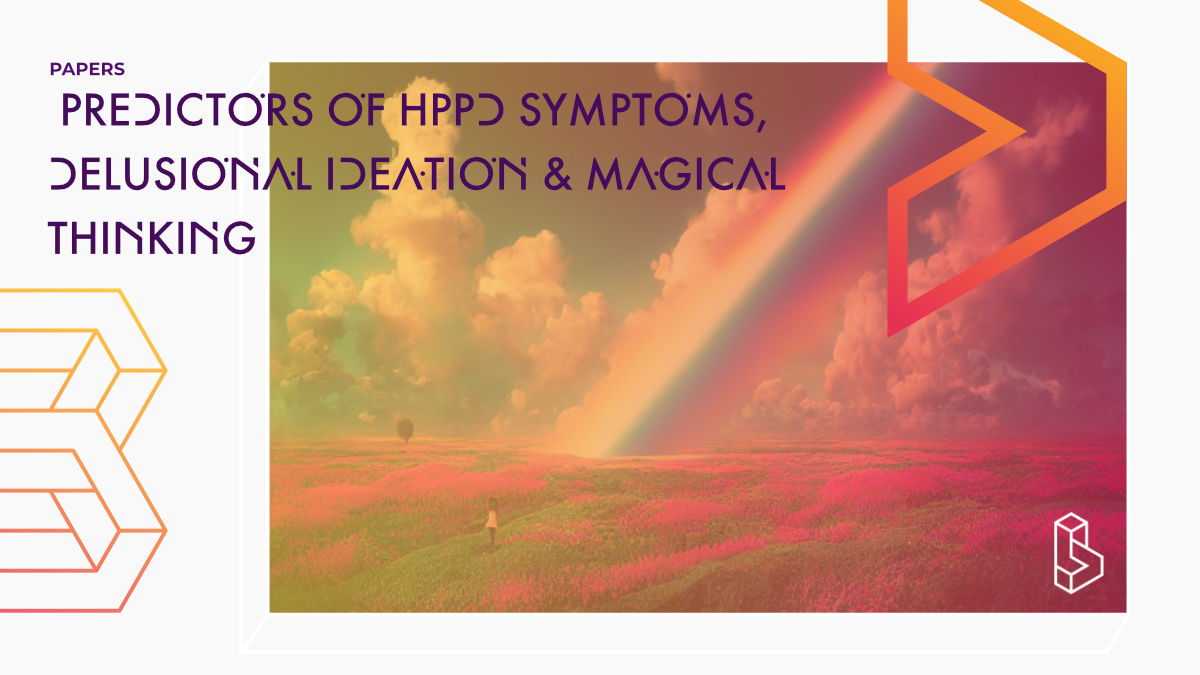This prospective cohort study (n=654 start, n=212 end) investigated delusional ideation, magical thinking, and HPPD symptoms in participants before and after planned psychedelic use. Results showed reduced delusional ideation after one month, no changes in magical thinking, and HPPD-like effects in 30% of participants (though rarely distressing at <1%), with younger age, female gender, psychiatric history, and baseline trait absorption predicting HPPD-like effects.
Abstract of Prediction of hallucinogen persisting perception disorder and thought disturbance symptoms following psychedelic use
“Interest in using psychedelic drugs to treat psychiatric disorders is growing rapidly. While modern controlled clinical trials show a favorable safety and efficacy profile, it remains unclear if the risk of side effects would increase with broader use in more heterogeneous populations. To address this, we investigated the frequency and baseline predictors of delusional ideation, magical thinking, and “hallucinogen persisting perception disorder” (HPPD)-related symptoms following psychedelic use in a self-selected naturalistic sample. Using a prospective cohort study, symptoms were assessed in ( N = 654 ) participants at one week before a planned psychedelic experience, and at two and four weeks afterward. Across the sample, delusional ideation was found to be reduced one month after psychedelic use ( P < 0.001 ) with no changes detected in magical thinking. These findings were in seeming opposition to positive correlations between lifetime psychedelic use at baseline with magical thinking ( r s = 0.12 , P = 0.003 ) and delusional ideation ( r s = 0.11 , P = 0.01 ), suggesting that schizotypal traits, instead of being caused by, may merely correlate with psychedelic use. Importantly, over 30% of the sample reported HPPD-type effects at the 4-week endpoint, although rarely perceived as distressing (< 1% of the population). Younger age, female gender, history of a psychiatric diagnosis and baseline trait absorption predicted the occurrence of HPPD-like effects. This is in line with prior studies showing a high prevalence of HPPD-like symptoms in psychedelic users, which, however, appear to remain at a subclinical severity in most cases, explaining the comparatively lower prevalence of HPPD diagnoses.”
Authors: Katie Zhou, David De Wied, Robin L. Carhart-Harris & Hannes Kettner
Summary of Prediction of hallucinogen persisting perception disorder and thought disturbance symptoms following psychedelic use
We previously covered this study as a pre-print in November 2022.
Psychedelics have been shown to elicit potent effects on emotion, cognition and perception. They have shown promising results for treating mood and addictive disorders, as well as positive, long-lasting changes in behaviour and personality in healthy individuals. Although the use of psychedelics in modern controlled research is generally considered safe, case reports of serious adverse reactions to recreational, naturalistic psychedelic use suggest that these substances are not without risk.
The most salient concerns regarding the intrinsic side effect profile of psychedelic drugs are their potential to trigger psychotic episodes or enhance schizotypal tendencies in healthy individuals, and to induce enduring visuoperceptual aberrations, which are clinically recognised as hallucinogen persisting perception disorder (HPPD).
Find this paper
https://doi.org/10.1093/pnasnexus/pgae560
Open Access | Google Scholar | Backup | 🕊
Cite this paper (APA)
Zhou, K., de Wied, D., Carhart-Harris, R. L., & Kettner, H. (2025). Prediction of hallucinogen persisting perception disorder and thought disturbance symptoms following psychedelic use. PNAS nexus, 4(4), pgae560.
Study details
Participants
654
Humans
Authors
Authors associated with this publication with profiles on Blossom
Robin Carhart-HarrisDr. Robin Carhart-Harris is the Founding Director of the Neuroscape Psychedelics Division at UCSF. Previously he led the Psychedelic group at Imperial College London.
Hannes Kettner
Hannes Kettner is a Ph.D. student at the Imperial College Centre for Psychedelic Research and a Scientific Officer at MyDelica. He is interested in studying real-world psychedelic use, including ceremonies, retreats, burns, and what we can learn from them about creating a positive set & setting.
Institutes
Institutes associated with this publication
Imperial College LondonThe Centre for Psychedelic Research studies the action (in the brain) and clinical use of psychedelics, with a focus on depression.
Linked Research Papers
Notable research papers that build on or are influenced by this paper
Abnormal visual experiences in individuals with histories of hallucinogen use: A web-based questionnaireThis questionnaire-based study (n=2455) found that the risk of Hallucinogen Persisting Perception Disorder (HPPD) may increase with greater past exposure to specific hallucinogens, symptoms were rarely (4.2%) perceived as distressing/impairing.
User perceptions of the benefits and harms of hallucinogenic drug use: A web-based questionnaire study
This survey study (n=626) investigated user perceptions of the benefits and harms of using LSD, psilocybin, MDMA, cannabis, ketamine, and alcohol. Overall, LSD and psilocybin were regarded as having the most positive impact on wellbeing, and the least harms in terms of physical and mental health.

